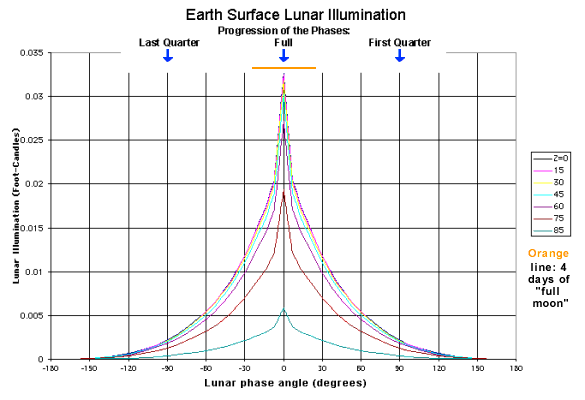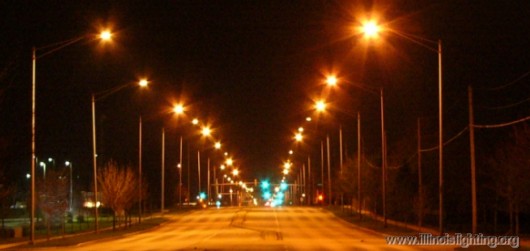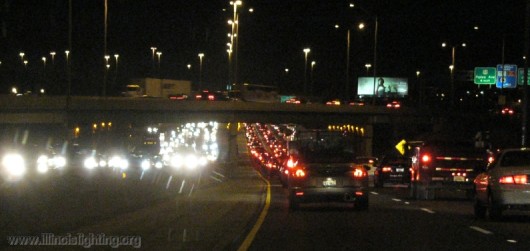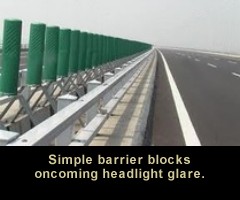Working toward legislation to curb light pollution in Illinois.
|
We find references to the use of moonlight for nocturnal activity in many places in both the historic record and in folk wisdom. The moon provides its most substantial illumination of the landscape at the time of full moon (see below); full moons are particularly associated with nocturnal activity. The name "Harvest Moon", for the full moon occurring nearest to the autumnal equinox, refers to the fact that the moonlight at that time is bright enough (and moonrise occurs in conjunction with sunset) to allow harvesters in the northern hemisphere to continue their work in the fields into the night. The same effect gives us the name of the following full moon, the Hunter's Moon.
How much illumination does moonlight provide to the landscape, and can we use this information as any sort of guide as to how much illumination we need to provide artificially, when moonlight isn't available? As it turns out, the level of illumination to the landscape provided by the moon varies greatly. Besides the clarity of the air (including the presence or absence of clouds), the two main variables are the phase of the moon (the percentage of the visible moon face illuminated by sunlight) and the elevation of the moon in the sky. One of the best analyses of the level of illumination provided by the moon which we've found was created by C.D. "Kit" Courter, and is available on his webpage, How Bright is Moonlight?
The moon's surface features the interesting property of retroreflectivity; the lunar surface tends to reflect light directly back in the direction it came from. So the moon appears brighter in the sky as it get full not only because a greater percentage of its Earth-side face is illuminated, but also because the light source, the sun, gets close to being in line behind the observer on Earth. This effect creates a sharper peak in the illumination provided by the moon in the days and even hours around full moon than the increased percentage of illuminated lunar face would on its own. What do we find from this work? The moon reaches a peak brightness for a short time around its full stage, and illuminates the ground by a varying amount through the night, as its elevation in the sky changes. Just two days either side of full brings the illumination down to 1/2 of the maximum it reached at full. There is a lot of variation from full moon to full moon, depending on the peak elevation it reaches in the sky, and the distance from the moon to Earth (the moon's orbit isn't a perfect circle, and its apparent size in the sky varies, causing as much as about 30% change in the illumination it provides). What we see is a theoretical peak in the illumination the moon could provide of around 0.03 foot-candles (exactly full moon, directly overhead), but that what most people (including our friends in the Lunar Society) would consider to be "full" probably averages half that at most, around 0.015 f.c. How does this relate to modern lighting practices? Most current common illumination practices far exceed "full moon" lighting levels. For example, the IESNA recommends that an expressway, away from an interchange and with low potential for pedestrian conflict, be illuminated to 0.9 foot-candles. This is sixty times brighter than the average for bright full moon light we derived above. Is there a rationale for this? Two factors come into play: The nature of human visual response, and the methodology used to develop the recommended lighting practices. Visual Response in Low Light Conditions The human visual system varies in response to the luminance of the objects in the scene it is observing, which is not the same as the illumination which is lighting up the scene, but is related to it. While the actual luminance of objects viewed under moonlight will vary depending on not only the aspect of the moon in the sky, but also the angle of illumination and the reflectivity of the objects, this 0.015 f.c. provides enough light for the eye to see a general scene using mesopic vision ("twilight vision", using both the retina's rod cells and cone cells). Scotopic ("nighttime") vision has different features than photopic ("daytime") vision; it is monochromatic, lacks the ability to see sharp detail (as is needed, for instance, to read normal print by), and gives reduced depth perception. It does provide a general wide-field view of a scene, and is useful for detecting motion. Scotopic vision is also sensitive to "overload"; brighter light within the field of vision can desensitize the rod cells, and such a loss of dark adaptation can leave one visually impaired until the eye re-adapts after the bright light source is removed. Mesopic vision blends the features of photopic and scotopic vision; visual acuity and color perception are reduced from what is achieved under full daylight, but are better than those under the even dimmer, rod cell only scotopic vision. Real-world Lighting Practices The IESNA recommendation for highway illumination noted above was based on achieving a level of illumination to detect visual targets placed on the roadway using photopic vision in a model scenario. This test setup relied entirely on the roadway lighting; the fact that vehicles are required by U.S. motor vehicle standards to come equipped with lighting to provide "adequate illumination of the roadway" (i.e. headlights) was not included in the model. The IESNA measurements are also only based on horizontal illumination, i.e., the level of illumination on the ground surface (or a horizontal plane above it); objects which we need to see in our field of view are often more (or fully) vertical, and measuring only horizontal illumination does not give an accurate reading of visibility. (One can see the difference when comparing streetlights to vehicle headlights; the former tend to shine downward, providing better horizontal illumination, while the later tend to shine out parallel to the ground; the headlights might score lower on the horizontal measure, but actually illuminate a vertical surface more effectively.)
Signs are individually illuminated, and/or reflect the vehicle headlights. (Indeed, most highway signage is, like the lunar surface, retroreflective -- it is most visible from vehicle headlight illumination coming from the direction of the vehicle operator's eyes, not from general area illumination.) And the glare from oncoming headlights is so severe that visual sensitivity is reduced considerably, rendering even the relatively bright overhead illumination less effective. All in all, the modeling used to develop this often referenced roadway illumination standard (and many similar recommended practices) is too far removed from some of the practical realities of the tasks we need to perform at night, from cost effectiveness, and from the functionality of the human visual system. It also fails to take into account how the human eye responds to light of varying wavelengths, something we've learned is of great importance, especially at lower light levels. Real-world Lighting Solutions Another reason why even our "minimal" outdoor lighting installations, especially on roadways, have so far exceeded the moonlight levels which our ancestors used to be able to function by is a vicious circle caused by the ready availability of bright electric lighting. Once a bright light source is added anywhere in a nocturnal scene, all fainter illumination loses effectiveness. Lighting on signs and properties along roadways gets brighter as new technology allows, and it gets harder to see the roadways, so roadway lighting is increased. Vehicle headlights get brighter (they have increased in output by more than eight times in the last 60 years), and that lights up the roadway for the operator more, but also increases the glare for oncoming drivers, reducing their night vision ability. Even vehicle marker lights and dashboard lights have gotten brighter; again, this actually reduces night vision, and creates an impetus to bring all illumination up toward daytime levels, rather than practical night levels.
We must put an end to the rapid upward spiral of intensity in our outdoor lighting; a spiral which is not slowing, but actually continues to accelerate. We must develop better standards, and bring more uniformity to the levels of illumination both provided and allowed. We have the technology to do this, and can both increase safety and slash power consumption in the process. We can stop continually making vehicle headlights brighter, just because that "upgrade" is a showroom selling feature; we can have other vehicle lights (like brake lights) be bright in the daytime sunshine, and dimmer at night (by simply dimming them when the headlights are on). We don't have to return to the era of only going out on nights where a full moon provides the illumination, but we can learn from that era something about sensible lighting. |
Return to Page TopThis page available as an Adobe Acrobat document Here |
|||
light pollution Illinois Chicago Cook County DuPage County Will County Springfield energy enviromnent global warming anti light pollution legislation lighting ordinances |
|||


 We humans are biologically a diurnal species. While all of our other senses function as well at night as during the day (or perhaps sometimes even more sharply), our eyesight is limited in its low-light capabilities. For tens of thousands of years, our ancestors were restricted in their ability to function between evening and morning twilight.
We humans are biologically a diurnal species. While all of our other senses function as well at night as during the day (or perhaps sometimes even more sharply), our eyesight is limited in its low-light capabilities. For tens of thousands of years, our ancestors were restricted in their ability to function between evening and morning twilight. Moonlight gardens, designed to be enjoyed during the night, were enjoyed in the orient for centuries; the 17th Century Taj Mahal in India featured a large garden meant to be visited during the cool of night. In England, some of the greatest creative minds of the 18th Century formed the Lunar Society of Birmingham; they met to discuss natural science and philosophy each month on the evening of the Monday nearest the full moon, so their members could travel home safely after dark by moonlight.
Moonlight gardens, designed to be enjoyed during the night, were enjoyed in the orient for centuries; the 17th Century Taj Mahal in India featured a large garden meant to be visited during the cool of night. In England, some of the greatest creative minds of the 18th Century formed the Lunar Society of Birmingham; they met to discuss natural science and philosophy each month on the evening of the Monday nearest the full moon, so their members could travel home safely after dark by moonlight. Here is a graph of results from Mr. Courter's work (reproduced here with his permission). The vertical axis is the level of illumination that the moonlight provides on the ground on Earth (in foot-candles). The horizontal scale is the phase of the moon, noted in "quarters" on the top, and phase angle on the bottom (the latter being equivalent to the sun's position relative to a line through the moon and Earth; zero degrees equaling the sun being "behind" Earth, and the moon at full phase; 180° being the sun "behind" the moon, and the moon at new phase). The colored plot lines are for different elevations of the moon in the observer's sky; Z=0 (the top/black plot line) puts the moon directly overhead (at the zenith); the colored lines indicate the level of illumination with the same moon lower in the sky, by the number of degrees indicated (Z=60, for instance, places the moon 90 minus 60, or at 30° in elevation above the horizon).
Here is a graph of results from Mr. Courter's work (reproduced here with his permission). The vertical axis is the level of illumination that the moonlight provides on the ground on Earth (in foot-candles). The horizontal scale is the phase of the moon, noted in "quarters" on the top, and phase angle on the bottom (the latter being equivalent to the sun's position relative to a line through the moon and Earth; zero degrees equaling the sun being "behind" Earth, and the moon at full phase; 180° being the sun "behind" the moon, and the moon at new phase). The colored plot lines are for different elevations of the moon in the observer's sky; Z=0 (the top/black plot line) puts the moon directly overhead (at the zenith); the colored lines indicate the level of illumination with the same moon lower in the sky, by the number of degrees indicated (Z=60, for instance, places the moon 90 minus 60, or at 30° in elevation above the horizon).
 Vehicle headlights and other light sources are a feature on real roadways. (Lighting an empty street, as shown in the first photo in this section, is an absurd and tragic waste of energy, as we point out on
Vehicle headlights and other light sources are a feature on real roadways. (Lighting an empty street, as shown in the first photo in this section, is an absurd and tragic waste of energy, as we point out on  But from an environmentally responsible point of view, nighttime light levels are all we should be trying to achieve outdoors at night in most situations. We cannot afford either the monetary cost of illuminating our whole planet to daytime levels, nor the waste of the immense amount of energy required to accomplish that unrealistic goal. We also simply cannot afford the cost to the health of our natural environment, nor our own physical health, of such massive disruption of the natural night.
But from an environmentally responsible point of view, nighttime light levels are all we should be trying to achieve outdoors at night in most situations. We cannot afford either the monetary cost of illuminating our whole planet to daytime levels, nor the waste of the immense amount of energy required to accomplish that unrealistic goal. We also simply cannot afford the cost to the health of our natural environment, nor our own physical health, of such massive disruption of the natural night. Glare from oncoming headlights can be reduced on many divided highways by installing simple barriers in the median; this can cost much less than installing general lighting (as an attempt to make up for the vision lost to the headlight glare), and have none of the perennial operating expense. We can start illuminating roadways only where there is a proven cost effectiveness for such lighting, only to levels needed for specific visual functions, and taking into account the lighting systems which vehicles themselves carry. Many other types of outdoor lighting practice also are in real need of such analysis and clear-headed re-thinking.
Glare from oncoming headlights can be reduced on many divided highways by installing simple barriers in the median; this can cost much less than installing general lighting (as an attempt to make up for the vision lost to the headlight glare), and have none of the perennial operating expense. We can start illuminating roadways only where there is a proven cost effectiveness for such lighting, only to levels needed for specific visual functions, and taking into account the lighting systems which vehicles themselves carry. Many other types of outdoor lighting practice also are in real need of such analysis and clear-headed re-thinking.